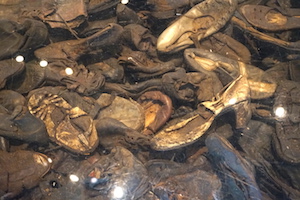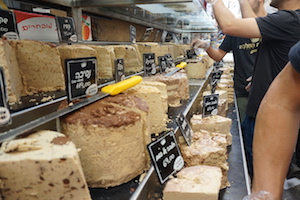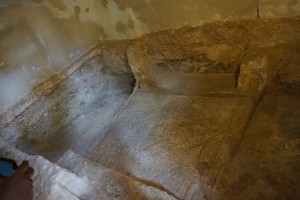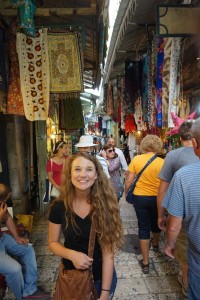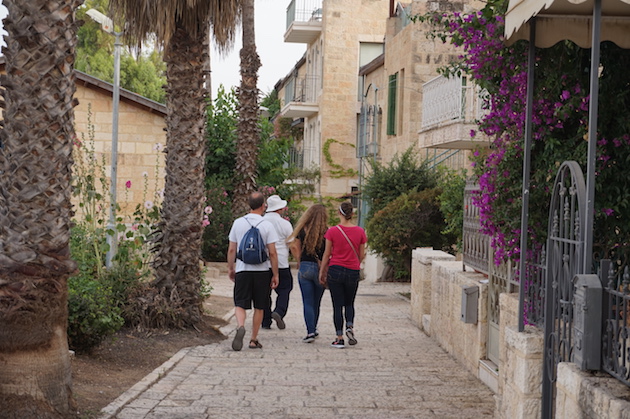Our Family trip to Israel. Jerusalem–the Holy City.
It was a cool night, as late May evenings often are in Jerusalem. Pleasantly warm days with cotton-candy clouds always seemed to lead to clear, 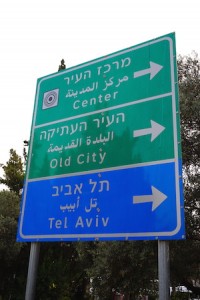 crisp evenings. Above the skyline, stars twinkled, possibly the same stars our family often gazes upon from our meandering, tree-lined driveway in rural Kansas City. In the cool night air, we strolled the Old City’s streets. It was well past midnight, yet we encountered countless families who were heading home from their Shabbat, or Sabbath, dinner with friends and family.
crisp evenings. Above the skyline, stars twinkled, possibly the same stars our family often gazes upon from our meandering, tree-lined driveway in rural Kansas City. In the cool night air, we strolled the Old City’s streets. It was well past midnight, yet we encountered countless families who were heading home from their Shabbat, or Sabbath, dinner with friends and family.
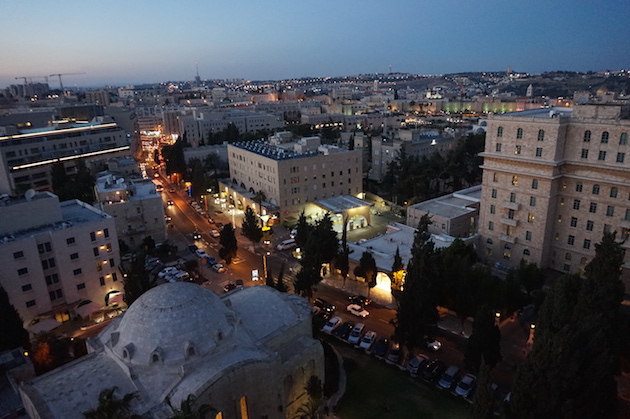
Jerusalem stone gives the city its iconic glow in the evenings. Here, seen from the top of the YMCA tower.
The city’s iconic architecture, built from a pale limestone called Jerusalem Stone, glowed warmly from the light cast by streetlights. Its winding streets and alleys were almost empty of vehicle traffic—as most Jews do not drive after sunset, when their Shabbat begins. We continued south on King George Street, stopping to admire the Great Synagogue. Banks, swanky home furnishing stores and cafés were all shuttered for the evening. The girls paused to admire the latest fashions in a dress shop window. Within 30 minutes, we were back at our hotel. The late-night walk was the perfect end to our second day in Jerusalem, the midpoint of our trip.
Part 1 Why a Journey to Israel is Right for You
In less than two full days, we had already experienced so much of Jerusalem, yet more treasures were in store. We had arrived in the holy city late in the afternoon the day before and checked into the Inbal Hotel—one of Israel’s finest thanks to the Israeli Ministry of Tourism, which not only created our tour itinerary, but also made all the hotel arrangements. This was a treat and not at all how we normally travel!
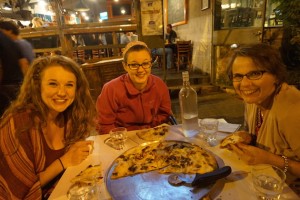
A light night dinner at a Kosher pizza joint in Jerusalem provided a peek at the city’s busy night life.
Trip pacing is important, and we’ve discovered that evenings should be reserved for relaxation, rejuvenation and preparations for the next day. Hannah suggested each day end with swimming, so the girls decided to stay behind at the pool while Dwight and I explored the surrounding neighborhood on foot. At 9 p.m. and hungry for a more familiar menu, the four of us reconnected, finding an Italian restaurant around the corner. Even without pepperoni, the girls fell in love with their first kosher pizza. (See the article explaining kosher food).
The next morning, we began our day with a visit to Yad Vashem, a 45-acre memorial complex that includes the Holocaust History Museum. The museum has a Kansas City connection, as architect Moshe Safdie, who designed the Kauffman Center for the Performing Arts, also redesigned the Jerusalem museum in 2005.

A family portrait includes no hint of the death and destruction that would soon visit each person pictured.
As we drove up to the complex, the architecture was striking. The building juts out almost precariously from a hilltop — appearing to teeter on the edge — perhaps symbolic of the world of the 1930s and early 1940s, when there was little support for the Jewish people.
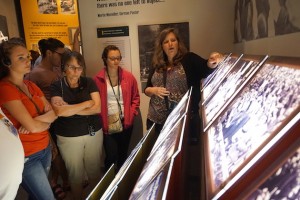
The Yad Vashem tour guide explains how the Holocaust began slowly, creeping into every day life and slowly bleeding away the rights of seven million Jews.
The Yad Vashem museum had changed significantly from our previous visits. Through personal stories, possessions, photographs, videos, diaries, and historical artifacts, it showcases as much as possible the personal histories of some of the 6 million people murdered in the Holocaust, as well as survivors. For instance, one picture, featuring a typical Jewish family was recovered at a concentration camp. The display identified each individual in the photo, describing his or her normal life before the War. It then recorded how each person met his or her death.
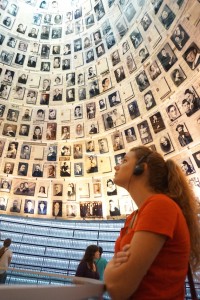
Emma gazes up at just a few of the faces of the millions lost in the Holocaust. The museum is perhaps the most somber, and important, place to visit in the Holy land.
The main goal of the complex is for no individual to be lost to history, but for each and every victim of the Holocaust to be remembered. The exhibits draw both young and old into these personal stories, and guests often find themselves viewing the exhibit through the blurred vision from eyes welling. We were no exception. Each of us dealt with the emotions it elicited in our own way.
The Old City
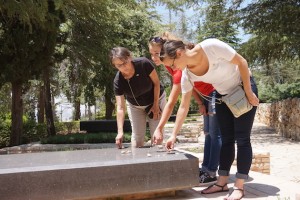
In the Jewish tradition of remembrance, Anita, Hannah and Emma lay a stone on Golda Meir’s grave. Meir was the fourth prime minister of Israel and a world leader for peace.
Anyone who visits Israel (unless you are part of a pre-planned group) can create a personalized itinerary that includes quirky museums, off-the-beaten-path beaches, out-of-the-way restaurants, and more. Our unusual stop was Mount Herzl National Cemetery, where Israel’s political leaders and soldiers are buried and honored. Emma was named after former Israel Prime Minister Golda Meir, and we wanted to visit her grave. As is the Jewish custom, we lovingly placed a stone on her marker.

Jerusalem’s many markets are where most of the city’s residents shop for food and necessities. They are also popular with tourists who are amazed by the hustle and bustle and seemingly organized chaos.
We visited Mahane Yehuda market—Jerusalem’s main open-air market. You can find American-style grocery stores in Israel, but an open-air market is a visual and sensory experience that visitors do not want to miss. We saw locals hurrying through the aisle preparing for Shabbat. In
American restaurants you may have two choices of a rich cake made from sesame flour and honey called Halva, but at this market there were 15 or more! Also called “the Shuk,” Mahane Yehuda is a perfect opportunity to buy gifts for your loved ones back home. You can buy clothing, spices, teas, meat, breads, sweets, fresh vegetables and olives. We took advantage of the offerings and enjoyed trying several items for lunch.

Israel is a true melting pot of cultures as Jews from around the world immigrate here to escape persecution. Here we enjoyed Indian cuisine in a candle lit restaurant.
Eating always brings challenges when traveling. Among them are the different times of day that each culture eats, unique smells and spices, what’s authentic and what has been Americanized. Our children are accustomed to eating ethnic food on vacation since it is our tradition that each family member takes a turn selecting a restaurant for our evening meal. In this culturally diverse region the question that often emerges is what is Israeli food? We ate Yemenite, Lebanese, Turkish, Arab and kosher meals. We also ate unknown and yummy food that was recommended by our tour guide and escort while in Jerusalem, Tel Aviv or in small villages.
Shabbat Begins
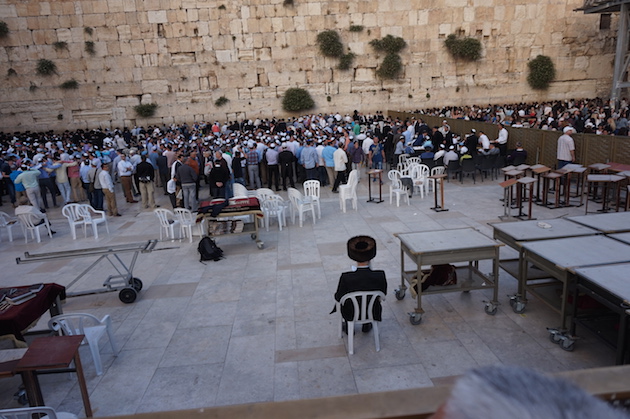
At the Western Wall, the most holy site in Judaism, worshippers gather to pray before sundown on Shabbat–the beginning of the Jewish sabbath.
As Shabbat begins, most Jews obey the Ten Commandments by not working (Christians could take a lesson). This includes not driving. After walking to synagogue services, observant Jews gather with friends and family for a traditional dinner. In most instances, guides and escorts will also take a break from their tours so they, too, may enjoy Shabbat with their families. Ours did as well and we were totally fine with the 20-minute walk to the Western Wall from our hotel and spending the evening on our own.
The Western Wall is a massive remnant of the retaining wall built by King Herod to widen the Temple Mount Plaza, during construction of the Second Temple (the Temple Jesus referred to in John 2:20). The Western Wall is the most significant Jewish religious site as it is the point nearest to the former location of the Second
Temple. (The Muslim Dome of the Rock now sits where the Temple stood.) Here at the wall, families celebrate Bar and Bat Mitzvahs and Israeli soldiers swear loyalty to their country. Planning to visit the wall during the Sabbath — sundown
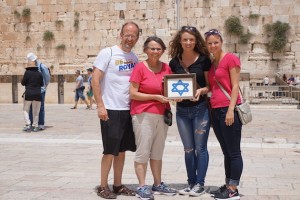
We visited the Western Wall twice. Once during mid-day wit light crowds and then again on Shabbat when young Jews danced and celebrated as they ushered in their day of rest. Here, we are pictured holding a Star of David that Anita’s late mother made and framed in the 80s while Anita lived and worked in Israel.
Friday to sundown Saturday — makes for a unique experience as local yeshiva students offer special prayers and Jews from around world sing and dance. Our family joined in the chaotic serenity found here by placing written prayer notes between the stones of the Wall. It was a contemplative moment and the girls were impressed by the passion of the young people.
New Friends
We’ve always found the best way to understand any country is to visit with locals, buy from locals and eat with locals. I arranged for a dinner
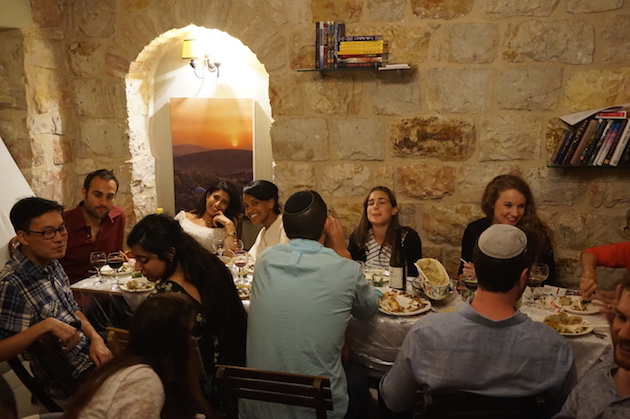
Through the website called Eatwith.com we scheduled a Shabbat meal with young Israelis. The girls counted this opportunity to visit with regular people one of the top picks for a trip. It was an opportunity to both ask and answer questions from inquisitive people from around the world.
through the website EatWith.com. It allows travelers to dine in the homes of famous chefs or well-known food enthusiasts. Patrons sign up online and then show up at the host home with fellow travelers from around the world. Knowing we would be in Jerusalem that day, I chose a dinner on Shabbat that was hosted by Sapir, described on the website as` a “psychiatrist and hip observant Jew.” As it happened that night, it
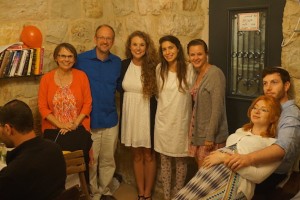
Pictured with our Shabbat host, Sapir who is between Emma and Hannah. As it turned out, the dinner was also a birthday celebration for one of her friends.
was also a birthday party for her fashion-model friend. Joining eight of her friends were other tourists like us, including a Chinese engineer for Disney Hong Kong, a professor and student from the Czech Republic, a Jewish-Canadian couple, a Swiss banker, and others.
During our meal together, I had a eureka moment after realizing that we were seeing prophecy fulfilled! There we were, sharing a Shabbat dinner with Jewish Israelis from Switzerland, Iran, Yemen, Tennessee, and Ethiopia. These were people whose parents — or they themselves — had made Aliyah, meaning returning to live in Israel. Jews have been doing this since the Babylonian Exile.
Emma and Hannah said it was one of the most cherished (and coolest!) activities of the entire trip because it allowed them to interact with Israelis on a personal level unprecedented for a typical vacation.
“It made me realize,” said Emma later, “that we’re more similar than different.”
Exploring Jerusalem
Because Jewish businesses are closed and there are few cars on the streets, Saturdays are quiet in Jerusalem. We began our day with the
Garden Tomb—one possible site for the death, burial and resurrection of Christ. Although the quaint garden is located outside the noisy Damascus Gate, it provides a peaceful setting for Christians to reflect.
Visible from the Garden Tomb and located at the intersection of two ancient Roman roads (chosen by the Romans for maximum visibility) is Golgotha, described as the “place of the skull” in the Bible. Those looking closely at the cliff can see an image of a skull. This hillside is part of Mount Moriah. Where Abraham took Isaac to be sacrificed, but then found a ram as a substitute—a foreshadowing of when John the Baptist proclaimed Jesus the “Lamb of God,” calling him a substitute for mankind.
Our kids have visited museums since they were two months old, but we try not to overdo it on vacations by picking wisely. Emma has reminded us that her generation is inquisitive.
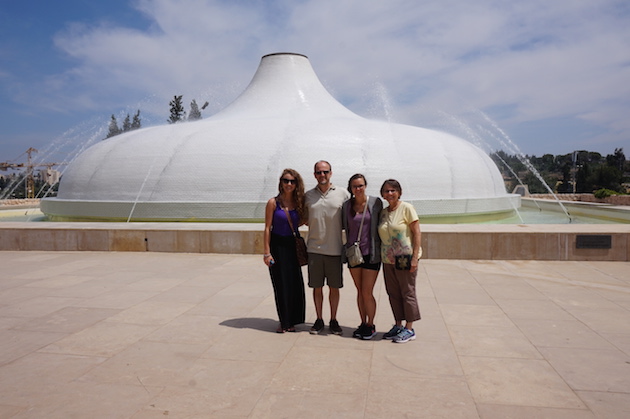 We visited The Shrine of the Book that displays the Dead Sea Scrolls discovered in a cave by a Bedouin boy in 1947. The lids of the clay jars that contained the scrolls inspired the shape of the museum. The scrolls contain the oldest Hebrew manuscripts of the Old Testament ever found and 900 additional scrolls were discovered in following years.
We visited The Shrine of the Book that displays the Dead Sea Scrolls discovered in a cave by a Bedouin boy in 1947. The lids of the clay jars that contained the scrolls inspired the shape of the museum. The scrolls contain the oldest Hebrew manuscripts of the Old Testament ever found and 900 additional scrolls were discovered in following years.
Outside the Shrine is a 1:50 scale model of ancient Jerusalem during Jesus’ time on earth. The replica allowed us to appreciate the wonder of the second Temple. Although the Shrine was
constructed in the 1960s, its been altered as new archeological details emerge. Viewing the model of the
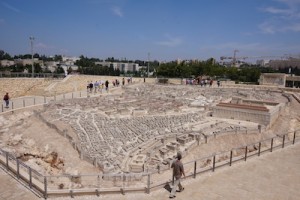
A scale model of Jerusalem from the Second Temple period sits outside the Shrine of the Book where the Dead Sea Scrolls are visible.
Temple and the area’s land features enlivens biblical comprehension. Hannah said visiting Israel makes you want to read the Old Testament because you are seeing history.
It is always wise to have a break from museums and enjoy the countryside. One such place is a small village in the Judean hills of southwest Jerusalem. Ein Karem is not listed as one of the top 15 sites, but it is where Zachariah and Elizabeth lived, Mary visited her cousin, and where
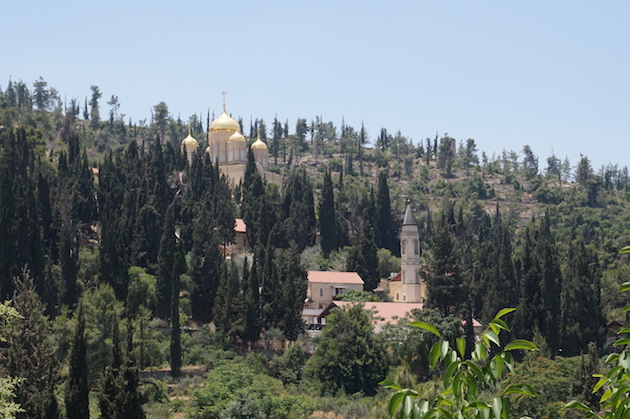
Ein Karem is popular with Israeli’s today as a quiet respite from he busyness of the city just over the hills. It was also popular with Mary, who visited Elizabeth here.
John the Baptist lived in solitude. Full of churches, the village is charmingly nestled between hills graced with green landscape, stone houses and Mary’s Well, where many visit to drink. Reminiscent of an artist colony, the village is a popular spot for Jewish families and for
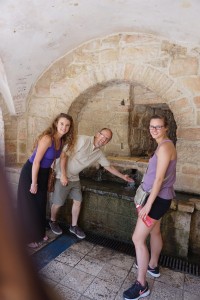
Dwight, Hannah and Emma visit Mary’s Well. Today, the spring is still there but made more easily accessible to visitors.
tourists to sip coffee, have a leisure lunch or just rest! It’s advisable to follow the winding road to the right of the well because the view only gets more quaint the higher one walks! We searched for a hostel that we were told had a spectacular garden but realized we were enjoying the garden of a private household! Fortunately, the owner was gracious.
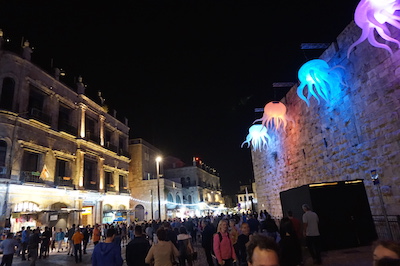
The Old City comes alive with modern art and a light show and draws hundreds of thousands of Israeli’s and their families for casual entertainment, food and of course, the spectacular light show at the Citadel Tower.
That night we were happy that our itinerary coincided with the Festival of Lights in the Old City. Imagine The Kansas City Plaza Lighting Ceremony, but in a 5,000-year-old city! The Old City’s architecture is the main backdrop, transforming it into a fairyland experience. Images were projected onto the city walls, and small children were fixated with the music and animation. Israeli and tourist families outside the Jaffa Gate were treated to huge blooming flowers bursting with color from the changing lights.
Later that night, we attended The Night Spectacular sound and light show at the Tower of David. The images of conquering armies pouring into the land of ancient Judea and Samaria flashed across the walls of the David Citadel Tower. It’s a high-tech show made possible by 20 projectors, 10 video players, 14 computers and 14 loudspeakers creating seemingly 3-D movements of people, animals and buildings—all set to heart-pounding original symphony music. We saw King David strumming a harp, the destruction of Solomon’s Temple, invading armies and more as Jerusalem is destroyed and rebuilt, each time a new people coming to take the place of the Israelites, who called it home for thousands of years. First Babylonians, then Romans, next came the Muslims, who were then defeated by the crusaders, but then later returned to vanquish the Europeans. Hannah said it helped her to create a timeline for the many ancient ruins she had explored during our trip.
The show is a good reminder that even today, Jerusalem is changing. It is no surprise that visitors who return to Israel often feel a bit disoriented.
Hannah and Emma’s favorite historical site was the City of David—the Jebusite village that David captured and made his capital. The site’s guide was engaging and kept our full attention.
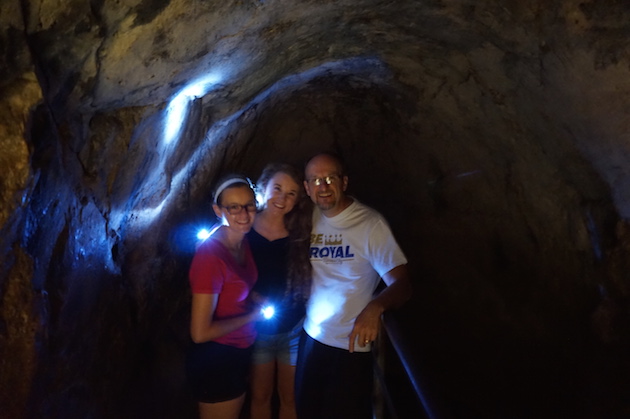
Our adventure in the City of David took us underground where we hiked with flashlights through knee-deep water in the original Hezekiah’s Tunnel!
Since the late 19th century, the City of David has remained an active archeological dig. Proof of its authenticity includes the personal seals of David and his officials, which were found in the ruins of the palace’s treasury. The historic site also allows visitors to descend down Warren’s Shaft, named after the Englishman who discovered it. Those who are claustrophobic can participate by watching an excellent 3-D film showing the history.
Some of the most exciting experiences in Jerusalem are deep underground. The suspense of walking with only a light from a flashlight through knee-deep water along the entire length of Hezekiah’s Tunnel is thrilling, if not a bit spooky. The 2,700-year-old tunnel was ordered built by King Hezekiah and was dug through solid rock, enabling water to run from the Gihon Spring outside Jerusalem to the city’s reservoir within the walls, thus protecting the city’s water supply (II Chron. 32). The tunnel ends at the Pool of Shiloh where Jesus healed the blind man (John 9)
One option for traveling up the hill to the Davidson Center is a tram, but being intrigued with the underground tunnels, we decided to walk to the Temple Mount through the ancient sewer system! That’s another moment that will capture the imagination of young travelers. The consensus of our family is that the City of David is a “must-do” activity!
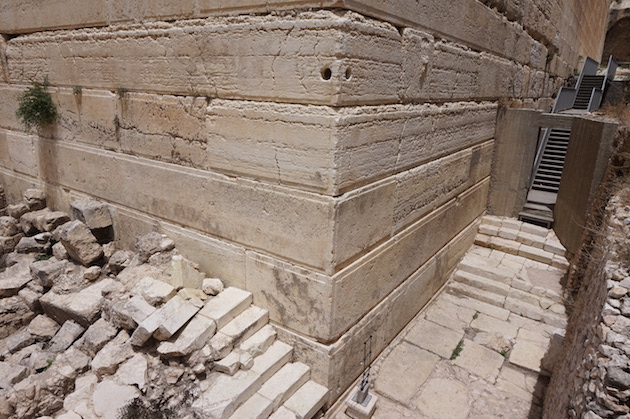
This is the corner of the Temple Mount seen in the diagram below. Notice how the steps are original.
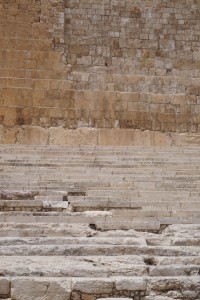
Climb the original steps that Jesus would have used to enter the Temple compound. The entrance gates have since been blocked by Muslim invaders. Today the Temple Mount holds a mosque with the remains of the Second Temple directly below it.
The Davidson Center is part of the Jerusalem Archaeological Park. At the Center, near the Western Wall, guests can view a short 3-D film explaining the Herodian Temple and the rituals of Jewish pilgrims during that Temple period. Around the corner from the Western Wall, visitors can ascend the original steps that Jesus would
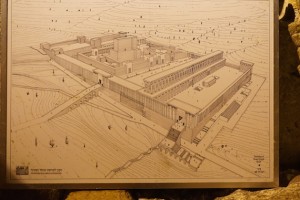
A diagram showing the Second Temple before the Romans destroyed it in 70 A.D. Today you can see the Temple building blocks where they landed as Romans pushed them from the wall above.
have used to access the Temple. Nearby is a section of enormous building blocks still in the same spot where they fell 12 stories to the ground when the Romans destroyed the Temple in 70 A.D. Still visible are indents where the weight of the blocks crushed the road.
Below the Davidson Center is a subterranean city—the Jerusalem that Jesus knew and on whose streets he walked. Totally destroyed and covered with rubble after the Roman siege, the city lay abandoned for centuries. Over the course of 1,000 years people filtered back into the area, using

A diagram shows how far underground Warren descended when he discovered the original streets of Jerusalem buried under two thousand years of rubble. Today visitors can still walk on those streets underground.
blocks of stone from the Temple to rebuild Jerusalem, not realizing the extent of the city below their feet. Invading Muslims took on greater building projects, constructing arches to level and support a new street level. After multiple destructions each successive street level continued to rise, being built on the ruins below.
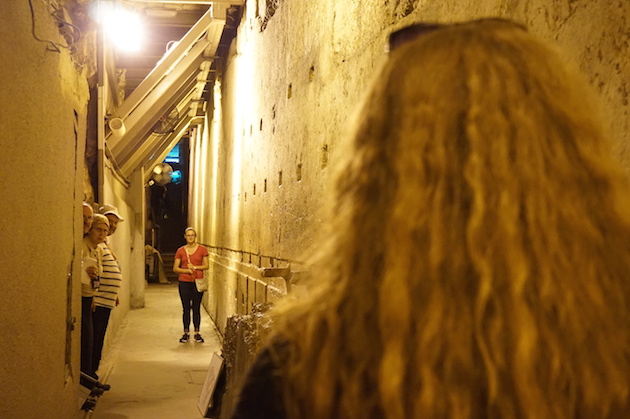
Hannah and Emma stand at opposite ends of one of the larger building stones of the Temple Mount wall. This one stone, say engineers, weighs as much as two fully-loaded 747 jets.
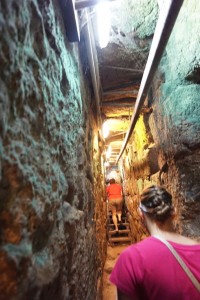
Young travelers will love exploring Jerusalem underground. Here you can tromp through a First-Century Roman sewer or walk the streets that Jesus and his disciples traveled. It’s a whole other world worthy of a sic-fi adventure or History Channel series.
For those enamored with Jerusalem’s underground, the Western Wall Tunnel offers another perspective. As it stands today, the exposed section of the Western Wall plaza is 187 feet long. The Western Wall of the Temple Mount runs another 1,050 feet underground and could not be seen until recently. Its excavation took 20 years and exposed an aqueduct, cisterns, a Herodian road, and more. Those who explore it with a guide will see what was once ground level, including the streets used by Jesus and His followers 2,000 years ago.
One amazing thing you’ll see is the original foundation of that Temple Wall. One block that deserves special attention is 41 feet long and weighs an estimated 570 tons—as much as two fully loaded Boeing 747s. How it was transported from the quarry to its location still baffles modern engineers.
The Old City
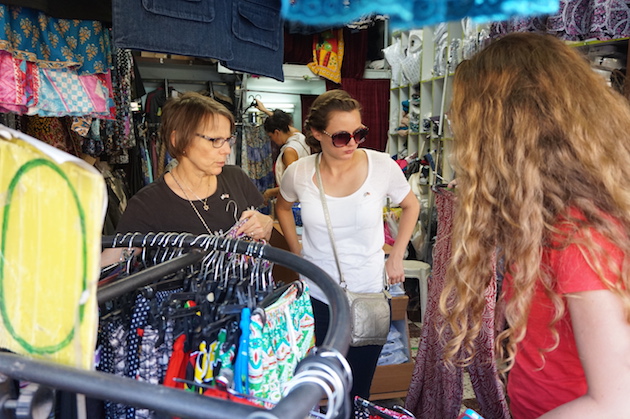
A visit to the Old City isn’t complete with out checking out the “Shuk”–the ancient market that still mesmerizes visitors today. Anita, Hannah and Emma spent time looking for the perfect dress or lounging pants.
For our girls, vacation also means time for shopping—looking for that perfect T-shirt as a reminder of the trip. Shopping in the Old City can be fun if you like to haggle, or dreadful if you don’t. Hannah preferred to shop in a trendy store at the new Mamilla Mall. Emma, though, just loves to buy anywhere, anytime. She found the perfect Star of David necklace in the 1,900-year-old Cardo area—–the Jewish Quarter known for art, jewelry and clothing.
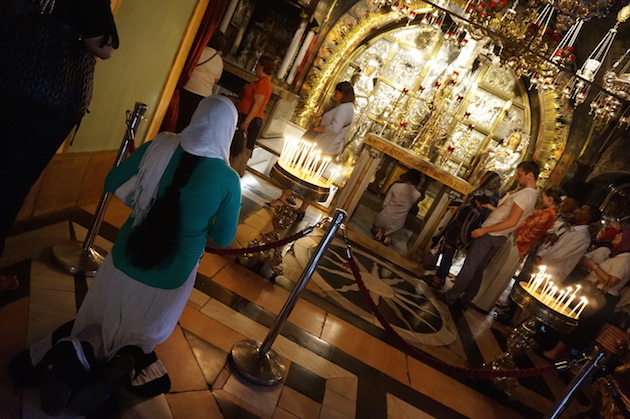
Pilgrims from around the world trek to the Church of the Holy Sepulchre. It is revered by Catholics, evidenced by long lines of people waiting to touch the rock tradition says the cross was inserted into.
A short walk away is The Church of the Holy Sepulcher, which some believe is the site of the crucifixion, burial and resurrection of Christ. The Church is maintained by six Christian denominations: Greek Orthodox, Armenian Apostolic, Roman Catholic Church, Coptic, Ethiopian and Syrian Orthodox. The church’s interior and worship services reflect its caretakers’ traditions and may seem foreign to Protestants. There is a beauty in the reverence of pilgrims from so many countries.
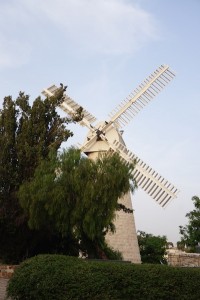
In the middle of Jerusalem stands a windmill. Still seemingly out of place in the city’s skyline, it’s useful landmark to get your bearings as you roam the city on foot.
Roaming is a great method of discovering and understanding any city and its culture since the neighborhoods often reflect the history of its founding. They also often invite unexpected surprises. The Yemin Moshe area near the Montefiore Windmill, for instance, is easily spotted as
seemingly out of place in Jerusalem’s mostly arid landscape. The contrast between the stone buildings and the colorful plants draws visitors down its multiple alleys, offering a scenic view of the Old City wall. On another walk back to the hotel we found ourselves at the Prime Minister’s house. Really—at the front drive! No blocks of concrete barriers here.
In another late night adventure, we sought out the International Christian Embassy, where I worked in the mid-80s. With a map and a few assists from the friendly locals, our mission was finally accomplished.
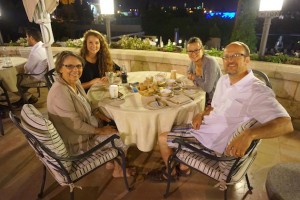
A late-night dinner on the veranda of the King David Hotel, which holds a central position in the history of the modern-day founding of the Jewish nation.
The evening concluded with a light dinner on the balcony at the King David Hotel where I remember indulging in hard-to-find “real” American coffee with another American volunteer.
Serendipitous Opportunities
Recognizing our love of the Holy Land, our guide Moshe arranged a last-minute change in our itinerary for a tour of the yet-unfinished Friends of Zion Museum. Dear reader, listen to the suggestions of your tour guide as this was in the top three of our experiences and a definite draw for Generation Xers.
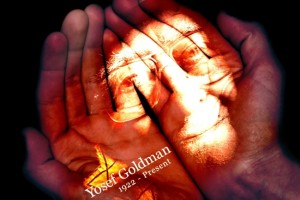
Friends of Zion Museum is one of Israel’s newest and features the story of gentiles who figured prominently in helping Jews over the centuries.
The tour opened with an impressive aerial view of modern Israel projected over a topographical model showing which Jewish tribe received the land. The museum then employs touch screens, holographic images, 3-D glasses, light effects and surround sound to tell the story of academia, business people, military, political figures, and ordinary Christians who aided Jews throughout history and worked toward Israel’s rebirth.
The museum uses these high-tech tools in spectacular fashion at the conclusion of the presentation, when many Christians who aided the Jewish people during the Holocaust are introduced. We were then asked to hold out our cupped hands. Suddenly, projected onto our palms, was the image and name of a person saved by these individuals. It was a heart-stopping moment as the display showed us that we each hold the fate of an individual in our hands. Hannah and Emma were deeply moved by the presentation and vowed to return on future trips.
In our next installment, follow us through the desert and the Dead Sea and back to Tel-Aviv as we prepare to depart the Holy Land.
By Anita Widaman
 Metro Voice News Celebrating Faith, Family & Community
Metro Voice News Celebrating Faith, Family & Community

